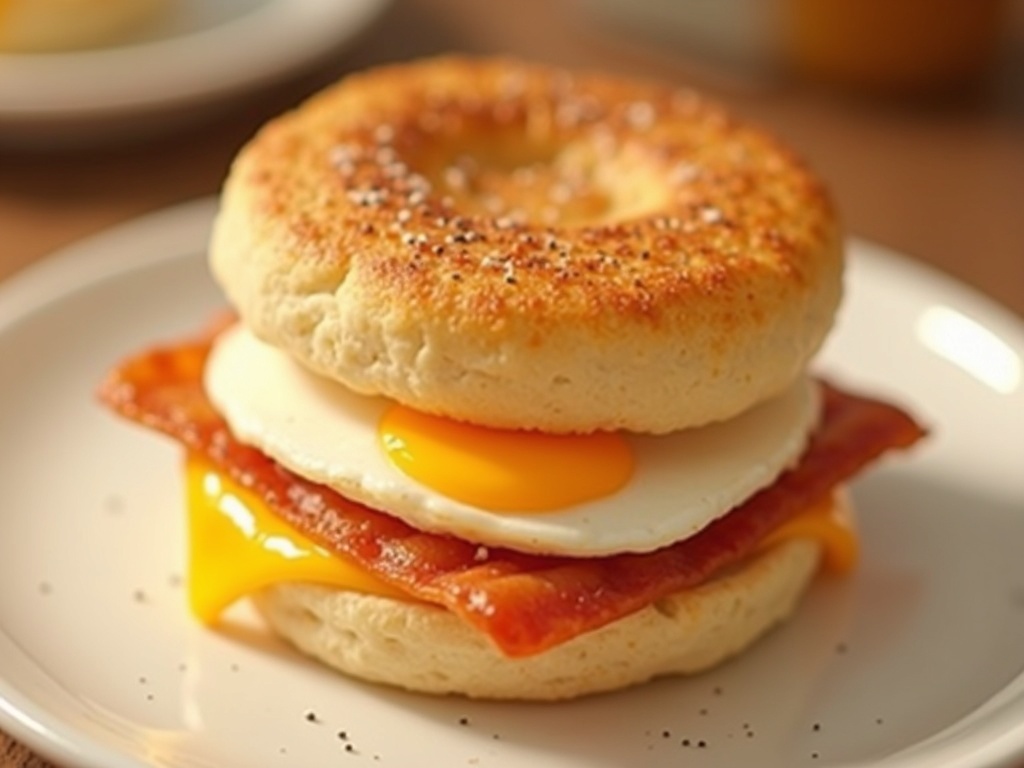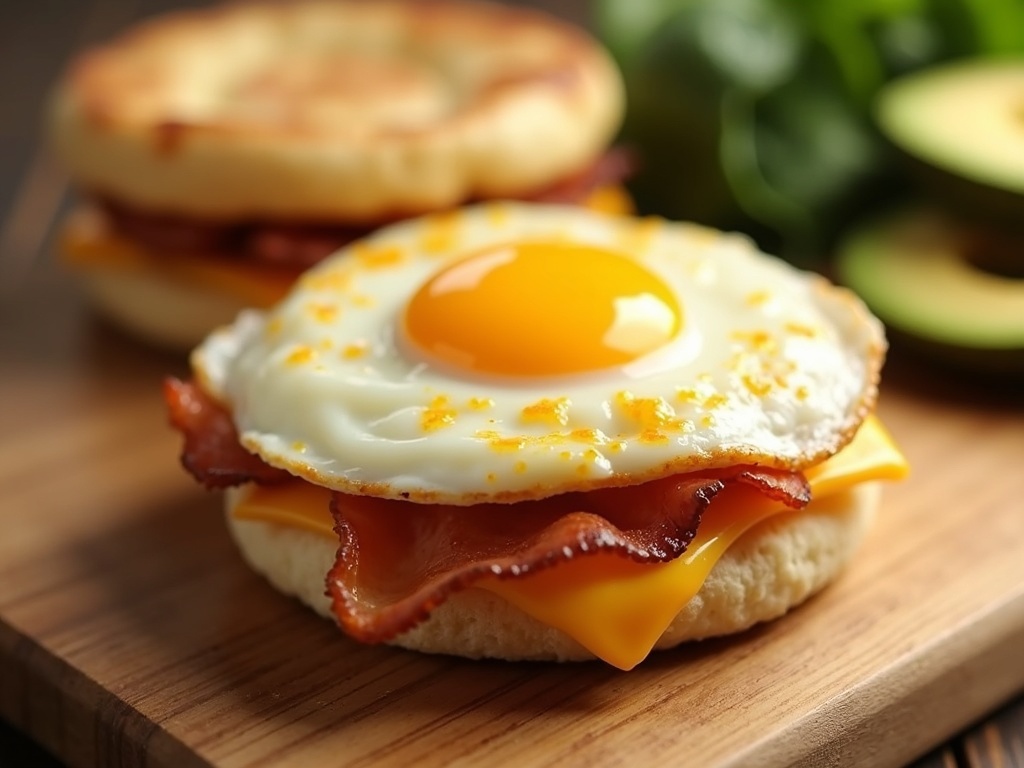The Mcdonald’s Egg McMuffin, introduced by McDonald’s in 1971, revolutionized fast-food breakfast by becoming the first successful item in this category and creating an entirely new market segment. This ingeniously simple combination of a round free-range egg, Canadian bacon, and American cheese on a toasted English muffin has sold over 700 million units worldwide in 2019 alone, accounting for more than 25% of McDonald’s breakfast sales.
Find In This Article
Key Takeaways
- The Egg McMuffin features quality ingredients including free-range eggs freshly cracked into special round rings, premium toasted English muffins, lean Canadian bacon, and perfectly melting American cheese.
- Each sandwich contains approximately 300 calories with 12 grams of protein and 7 grams of fat, making it a relatively balanced fast-food breakfast option.
- The sandwich established the template for virtually every breakfast sandwich that followed, influencing competitors and improving morning fast food options industry-wide.
- Home preparation requires specific techniques like using a metal ring mold for the egg and proper layering for authenticity.
- The Egg McMuffin can be customized with healthier alternatives like turkey bacon, added vegetables such as avocado or spinach, or spicy elements like jalapeños and sriracha.
The Fast Food Breakfast That Started It All
The Egg McMuffin revolutionized how Americans eat breakfast. Introduced by McDonald’s in 1971, this humble sandwich became the first successful fast-food breakfast item, creating an entirely new category in the quick-service restaurant industry. Before this innovation, breakfast was largely overlooked by fast-food chains, but the Egg McMuffin changed everything.
At its core, the Egg McMuffin features an ingeniously simple combination: a perfectly round free-range egg, a slice of Canadian bacon, and American cheese, all nestled between halves of a toasted English muffin. This balanced mix of protein and carbs created an instant hit that resonated with busy commuters looking for a quick, portable morning meal.
The popularity of this breakfast sandwich is staggering. In 2019 alone, McDonald’s sold over 700 million Egg McMuffins worldwide. This incredible figure represents more than just sales – it’s evidence of how deeply this menu item has embedded itself in global breakfast culture. The Egg McMuffin now accounts for more than 25% of McDonald’s breakfast sales, making it a cornerstone of their morning menu offerings.
Quality Ingredients Make the Difference
What separates the Egg McMuffin from other breakfast sandwiches is its commitment to quality ingredients. McDonald’s uses:
- Free-range eggs that are freshly cracked and cooked in special round rings to get that perfect shape
- Premium English muffins that are toasted to achieve the ideal texture – crispy outside, soft inside
- Canadian bacon that offers a leaner alternative to traditional bacon
- American cheese that melts perfectly, binding all ingredients together
I’ve noticed the attention to detail that goes into each McMuffin sandwich – from the careful toasting of the English muffin to the precise cooking time for the eggs. These standards have pushed competitors to up their breakfast game, improving morning fast food options for everyone.
The impact of the Egg McMuffin extends beyond just McDonald’s success. This humble sandwich established the template for virtually every breakfast sandwich that followed. From the Sausage McMuffin variant to countless imitators at other chains, the basic formula remains remarkably consistent.
For many travelers and commuters, grabbing an Egg McMuffin during McDonald’s breakfast hours has become a comforting routine. The sandwich offers the perfect balance between convenience and satisfaction – substantial enough to fuel your morning, yet neat enough to eat while driving.
The enduring popularity of the Egg McMuffin eventually led to McDonald’s expanding their morning offerings to include items like the McDonald’s Big Breakfast. The company even experimented with all-day breakfast options in response to customer demand, showing just how attached people have become to this morning classic.
When it comes to fast food innovation, few items have made such a lasting impact as the Egg McMuffin. This simple sandwich didn’t just create a new menu category – it changed how millions of people start their day.
What’s Inside This Iconic Sandwich
I’ve always been fascinated by the simplicity yet perfect balance of ingredients in McDonald’s Egg McMuffin. This breakfast staple packs quite a nutritional punch while maintaining its status as one of the lighter options on the McDonald’s breakfast menu.
Nutritional Breakdown
Each Egg McMuffin contains approximately 300 calories, making it a reasonable choice for a morning meal. The sandwich offers 12 grams of protein, which helps keep hunger at bay during those busy mornings. With just 7 grams of fat, it’s relatively lean compared to other fast food breakfast options.
The carbohydrate content sits at 29 grams, with 2 grams of fiber coming primarily from the English muffin. This balance of macronutrients makes the McMuffin a more balanced choice than many other breakfast sandwiches.
Key Components
The magic of the Egg McMuffin lies in its four core ingredients, each playing an essential role in creating that signature taste:
- English muffin: Toasted to perfection, providing a slightly crispy exterior with a soft interior
- Free-range egg: Freshly cracked and cooked in a circular mold to create that distinctive round shape
- Canadian bacon: A leaner alternative to regular bacon, adding a savory, slightly smoky flavor
- American cheese: Melted just right to bind everything together with creamy goodness
What makes the Sausage McMuffin different from the original is the replacement of Canadian bacon with a savory sausage patty, which alters both the flavor profile and nutritional content.
The preparation is part of what makes this sandwich special. Each egg is freshly cracked onto the grill, unlike some fast food places that use frozen egg products. The English muffin is toasted just enough to give it structure without becoming too hard.
Many McDonald’s locations also add a small amount of butter to the English muffin, along with salt and pepper on the egg. For those who enjoy customizing their meal during McDonald’s breakfast hours, you can request additional seasonings or even ask for no butter to further reduce the calorie count.
The Egg McMuffin is often featured as part of the McDonald’s Big Breakfast deal, paired with other morning favorites. Though it’s been a staple since the 1970s, it really gained popularity when McDonald’s introduced their all-day breakfast option, allowing fans to enjoy this sandwich beyond morning hours.
The careful balance of ingredients creates a harmonious blend of textures and flavors – from the slight crunch of the toasted English muffin to the soft, warm egg and the savory Canadian bacon. It’s no wonder this sandwich has maintained its popularity for decades.

Creating the Perfect Egg McMuffin at Home
I’ve perfected my homemade Egg McMuffin recipe after countless breakfast experiments, and now I’m ready to share my secrets. The iconic McMuffin can be recreated in your kitchen with just a few simple techniques that capture that fast-food magic.
Essential Preparation Steps
First, I toast an English muffin until it reaches that perfect golden-brown color with a slight crunch around the edges. This creates the ideal foundation for our sandwich.
While the muffin toasts, I cook a slice of halal turkey bacon (a great substitute for the traditional Canadian bacon) for about 2-3 minutes over medium heat until it gets slightly crispy around the edges but remains tender.
The egg is where the real technique comes in. I use a metal ring mold placed in a heated non-stick pan to create that signature circular shape that makes the Sausage McMuffin so recognizable. After cracking the egg directly into the ring, I add a splash of water to the pan and quickly cover it with a lid. This steaming technique perfectly cooks the egg in 3-5 minutes without flipping.
Assembly and Flavor Enhancement
Layering is key to capturing the authentic McDonald’s breakfast experience:
- Place the bottom half of the English muffin on your plate
- Add the perfectly cooked egg
- Top with the turkey bacon slice
- Add a slice of American cheese so it begins to melt from the heat
- Crown with the top half of your toasted muffin
I season with just a touch of salt and pepper to enhance the flavors. This simple finishing touch makes a remarkable difference in the final taste.
The magic of this homemade version is that you don’t need to worry about McDonald’s breakfast hours – you can enjoy this morning classic anytime. Plus, if you’re feeling ambitious, you can make a few extra and refrigerate them for quick reheating on busy mornings.
My homemade Egg McMuffin pairs perfectly with hash browns or fresh fruit for a complete breakfast that rivals the McDonald’s Big Breakfast experience. The best part? You can adjust ingredients to your preferences while still keeping that classic taste that makes the original so popular.

Common Pitfalls to Avoid
Making a homemade Egg McMuffin seems straightforward, but there are several mistakes that can turn your breakfast creation from delicious to disappointing. I’ve learned these lessons through plenty of trial and error, and I’m sharing them so you can nail your sandwich on the first try.
Key Mistakes That Ruin Your Homemade McMuffin
The egg is arguably the star of any Egg McMuffin, and overcooking it is the fastest way to ruin the experience. A properly cooked egg should have a slightly runny yolk that creates a rich, velvety sauce when you bite into it. I cook mine just until the whites are set but the yolk remains soft – about 2-3 minutes on medium heat is usually perfect.
Cheese melting problems can also sabotage your sandwich. After placing the cheese on the hot egg, I always cover the skillet for 30 seconds. This traps heat and ensures the cheese melts evenly without overcooking the other ingredients.
The foundation of any good McMuffin sandwich is a properly toasted English muffin. Skipping this step leads to a soggy, disappointing base that can’t hold up to the egg and other fillings. I always toast mine until golden brown, which adds both texture and flavor.
Using authentic English muffins makes a significant difference too. Substitutes like regular bread or biscuits change the entire character of the sandwich. The nooks and crannies of a real English muffin catch the egg and melted cheese in a way that other breads simply can’t match.
Timing is everything with a McDonald’s breakfast sandwich. Unlike some foods that improve with resting, an Egg McMuffin should be served and eaten immediately. The perfect temperature window is small – wait too long and the cheese congeals, the egg cools, and the magic is lost.
When crafting your own version at home, remember these pitfalls and you’ll create a breakfast sandwich that might even surpass what you’d get during McDonald’s breakfast hours. With a perfectly runny yolk, melted cheese, and properly toasted muffin, your homemade creation will satisfy those morning cravings without leaving the house.
Make It Your Own
The classic Egg McMuffin is fantastic as is, but I’ve discovered several delicious ways to customize this breakfast icon at home that align with various dietary preferences and taste profiles.
Healthier Adaptations and Flavor Boosts
Turkey bacon makes an excellent substitute for traditional bacon, cutting down on fat while maintaining that satisfying savory element. I’ve found it creates a lighter version that doesn’t sacrifice the essential McMuffin experience. For cheese lovers looking beyond American cheese, sharp cheddar adds a more pronounced flavor profile, while pepper jack introduces a mild heat that complements the egg perfectly.
I often add fresh produce to enhance both nutrition and flavor. A few slices of avocado contribute healthy fats and a creamy texture that pairs wonderfully with the McMuffin’s other components. For a veggie boost, adding a handful of baby spinach introduces nutrients and a fresh element to the classic McDonald’s breakfast sandwich.
Vegetarians can enjoy a modified version by replacing the meat with a well-seasoned tofu scramble. I prepare this by crumbling firm tofu and cooking it with turmeric, nutritional yeast, and black salt for an egg-like flavor and appearance. This adaptation provides protein while keeping the satisfying texture of the original.
For spice enthusiasts, transforming your Sausage McMuffin into a fiery morning wake-up call is simple. Fresh jalapeño slices introduce moderate heat, while a drizzle of sriracha sauce creates a more intense spicy experience. These additions pair particularly well with the McDonald’s Big Breakfast components if you’re making a full morning spread.
These customizations work whether you’re recreating the sandwich at home or modifying your order during McDonald’s breakfast hours. While the restaurant may not offer all these modifications, they often accommodate simple requests like removing meat or changing cheese options. For maximum flexibility, I recommend making your own version at home where you can experiment freely.
The beauty of these adaptations is they maintain the essential character of the Egg McMuffin while tailoring it to your specific preferences. Even when McDonald’s all-day breakfast isn’t available, these homemade variations let you enjoy your favorite morning sandwich anytime.
Sources:
Food & Wine, The Real Story Behind McDonald’s Egg McMuffin
USA Today, The History of McDonald’s Breakfast Menu
McDonald’s, Nutritional Information
JCR, The Breakfast Sandwiches and the Egg McMuffin Effect

